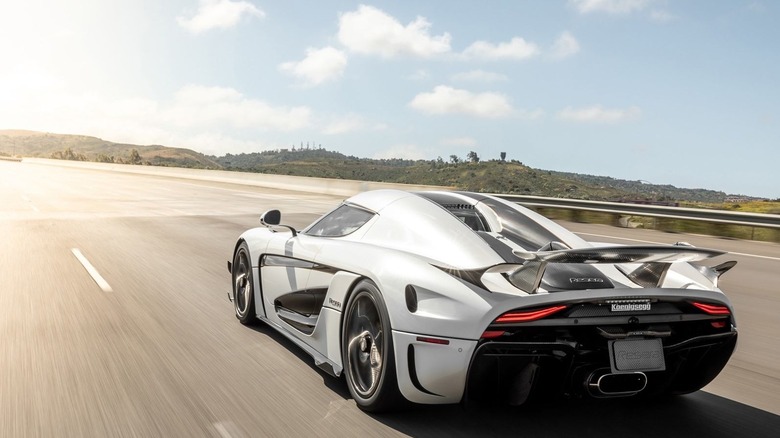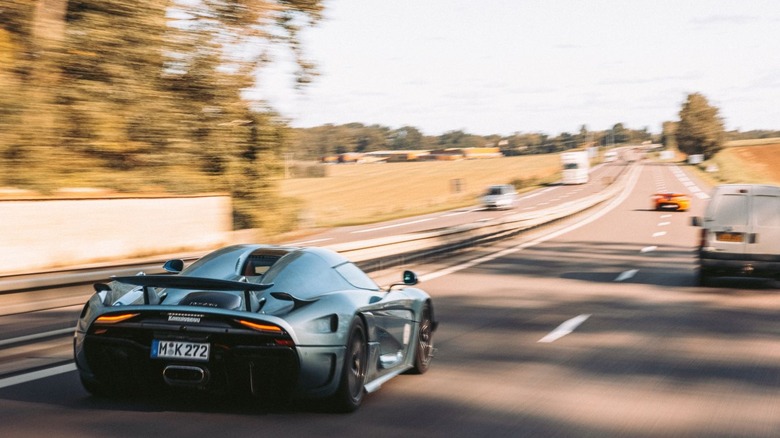Koenigsegg Regera Top Speed: How Fast Can The Hybrid Supercar Actually Go?
For most people who know cars, the name "Koenigsegg" needs no introduction — though sometimes a quick spell-check. If there's one thing these cars are famous for, it's being fast. Alarmingly fast, even, as evident in just about every model the company ever produced, dating back to the original CC8S. And if you thought those were extreme, wait until you see the Regera, a car to which Koenigsegg affixed the title of "Megacar," owing to how it seemingly outclasses many hypercars in terms of outright speed. But how fast is it, really?
The answer is: That's actually a good question. Koenigsegg has limited the top speed of the car to 255 mph, or 410 km/h, which is still eye-wateringly quick, of course. However, it doesn't touch the likes of the few cars that have broken 300 mph, a barrier that's difficult but not impossible to breach in road-legal cars. That still leaves us with the fundamental question, though — if the car is electronically-limited to 255 mph, how fast would it go with those limiters removed?
Sadly, we don't have a spare Regera lying around to try this out with, nor have any owners been reckless enough to disable this electronic limiter and truly figure it out. Instead, we'll have a look at the physics of driving that quickly, compare it to similar cars, and have a look at its overall characteristics to come up with a rough theoretical estimate. Let's start with the Regera itself, namely its powertrain and aerodynamic characteristics — the two properties that matter most in land speed running.
How a 255-plus mph car works
Under the hood rests a twin-turbo 5.0L V8 and three electric motors, producing a combined total of 1500 horsepower, 700 of which is available in electric-only mode. This is coupled to Koenigsegg's proprietary Direct Drive transfer system; rather than featuring a transmission like any other combustion engine car, the Regera instead simply drives the wheels directly, much like an aircraft propeller connected to the crankshaft. This eliminates the need for shifting gears entirely, simply brute-forcing its way through the RPM band with the electric motors providing ample low-end torque.
The end result of this black magic is one of Koenigsegg's fastest machines: a record-breaking automobile, that record specifically being a sprint from 0 to 400 km/h (249 mph) and back to 0. The Regera's time sits at a cool 28.81 seconds, a testament to both how hard this thing accelerates as well as slows down.
As for the two secret ingredients required to accomplish this, the first is the power — we can check that box fairly readily. The second is the aerodynamic coefficient, which, in simple terms, is how well the car slices through the air. Koenigsegg never publicly disclosed this number, unlike other cars more designed for outright speed, like the Jesko Absolut. With active aero off, the Jesko produces a 0.278 coefficient of drag, which is still roughly double that of purpose-built land speed cars. By contrast, the Regera, without active aero disabled, produces three times more downforce at 155 mph than the Jesko — 992 pounds versus 331. That's a lot of extra drag to overcome, with 100 less horsepower than the Jesko.
So how fast is it, theoretically?
The Regera noticeably underperforms in comparison to the Jesko Absolut, which isn't too surprising — the Jesko beats it in the 0-400-0 test by over 3 seconds, giving us a fair baseline. Christian von Koenigsegg hinted at the Jesko's true top speed to be in excess of 330 mph, though no concrete proof has been confirmed as of yet, which gives us a rough goalpost.
As for the Regera, it will rely on two factors: peak horsepower, which tapers after a certain engine RPM, and overcoming air resistance. As mentioned before, the Regera has about three times the amount of downforce at 155 mph compared to the Jesko, which the car must overcome in exponential amounts as the speed increases. Given that we don't have an accurate coefficient of drag for the Regera — it wasn't built for top speed, after all — we'll have to speculate on this. Let's do some math.
The Jesko has a frontal cross-section of 20.23 ft², which means that at 255 mph, it produces 933 pounds-force of drag at atmospheric density, which requires about 634 horsepower to maintain with its aerodynamics. Three times the aero would mean three times the power, going over the Regera's 1500 horsepower limit. However, we don't know its frontal cross-section, nor its coefficient of drag. Given that it's limited to 255 mph, it's likely more slippery, just with more aero. Thus, assuming active aero is disabled and it has the correct power band, it might go around 280 mph, but that's just an estimate. We'll happily accept a Regera for additional testing, just to be sure.


